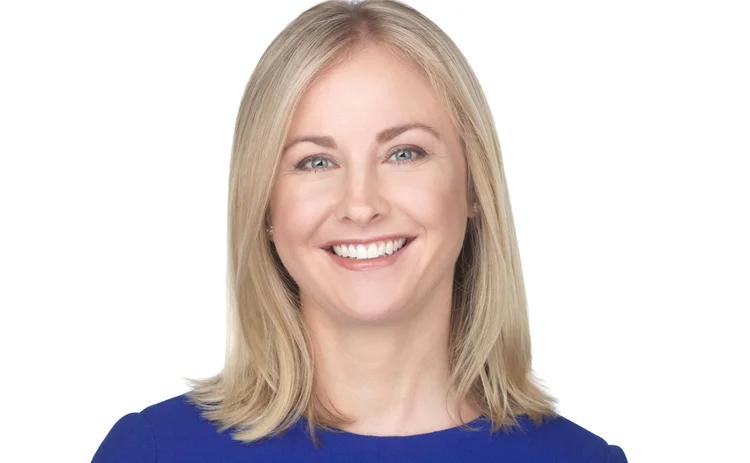
Clearing house of the year: CME Clearing
Risk Awards 2024: Firm balances basis trade, rolls out new margin model and moves off USD Libor

In the 12 months to July, the US Federal Reserve raised interest rates eight times, taking them from 1.5% to 5.25%. This rates hiking cycle – the most significant for nearly two decades – combined with external shocks, such as the US regional banking crisis, to create record volumes for CME Group’s futures exchange. Open interest in US Treasury futures rose from around 14 million contracts in January 2022 to 20 million this month.
Although this was good news for the exchange business, it created challenges for CME’s clearing unit, which is responsible for prudently managing the risks. CME Clearing proactively increased margin levels – aggregate interest rate margins have risen two-thirds since the cycle began – and did so without destabilising the market.
Suzanne Sprague, CME’s global head of clearing and post-trade services, says: “It’s very much our role as a systemically important clearing house to not only manage the risk that we have here, but keep in mind the financial stability of the broader marketplace.”
The consensus within the market is that CME Clearing discharged its duties admirably.
A clearing executive at a large bank says: “They’re very thoughtful around the changes they make within their margin frameworks and they’re good at explaining why.”
The head of derivatives at a US bank says CME is “pretty good at measuring against the volatility. I think they’re quick to respond based on where they see movement happening.”
It’s very much our role as a systemically important clearing house to not only manage the risk that we have here, but keep in mind the financial stability of the broader marketplace
Suzanne Sprague, CME
In the past 12 months, CME has also moved its energy products on to the new Span 2 margin platform, helped the market transition away from USD Libor, and finalised a cross-margin agreement that will improve margin efficiency for the US Treasuries basis trade.
The latter issue has been a particular focus for CME Clearing. Increased volatility in rates has led to growth in Treasury relative value strategies, which exploit pricing differences between related securities. This, in turn, has led to increased demand for Treasury futures. One broker’s chief risk officer (CRO) says CME has managed the risk effectively by setting “reasonable” margins that take into account members’ creditworthiness: “If everyone held everyone to stress, the market would kind of seize up.”
The CRO adds that in the Treasury basis trade, margins have been “appropriate” and that CME is not procyclical in increasing margin: “I’ve seen them proactively increase margins. They could do something where it’s draconian levels, and then liquidity dries up and it becomes a bigger problem. So I think they found that healthy balance.”
The CRO of a proprietary trading firm that trades the basis says CME’s recent approach to margining compares favourably with its reaction during the pandemic, when there was less time to reposition around margin changes.
In recent months, regulators have expressed concern about how sudden fluctuations in the leverage associated with trading Treasury futures might create “destabilising margin spirals”. However, clearing sources argue leverage in the Treasury basis trade is not as high as some claim. The head of clearing at a futures commission merchant (FCM) says: “If the margin requirement on the five- or 10-year note is a few per cent, I would be surprised if you got more than 50 times.” If 2% is paid at the contract level, then 50 times is the maximum possible level of leverage, even before a clearing house levies concentration add-ons at the portfolio level, where liquidation of same-day positions would be challenged.
CME’s own studies show that growth in short open interest (OI) in Treasury futures has been less than the increase in outstanding US marketable debt.
Marginal gains
Sprague says CME Clearing adopts a “multifactoral approach” to margins. “It’s product-level, taking into account volatility within certain marketplaces,” she says. “But it’s also looking at things like concentration and the portfolio effect that we have with our own products as well as with our cross-margin programmes.
“There are a variety of quantitative factors that we take into account, both on a historical basis … through data analysis, as well as forward-looking measures, like implied volatility.”
The clearing house conducts daily back-testing by assessing portfolio margin coverage. It has maintained its margin coverage standard of 99% at all times since back-testing has been applied, including going back before the global financial crisis.
Market volatility often decreases in the run-up to known events that might have an impact on prices, such as elections. This is why CME uses qualitative measures to increase margin buffers in anticipation of price moves that might occur once such events have taken place. In determining extreme but plausible market scenarios, historical market moves are reviewed to construct hypothetical stress-testing shocks.
CME Clearing takes into account factors such as geopolitical uncertainty, inflation prints and central bank policy changes. “Those types of metrics aren’t necessarily always reflected already in the data,” says Sprague. “We take into account several different qualitative factors in the margin setting process, regardless of margin model, to make sure that we’re forward-looking as well.”
There are a variety of quantitative factors that we take into account, both on a historical basis … through data analysis, as well as forward-looking measures, like implied volatility
Suzanne Sprague, CME
She adds that anti-procyclicality measures are in place to smooth out increases and decreases appropriately: “So we’re not artificially reacting too quickly to changes in volatility either on the upside or the downside, we take into account things like floors and periods of increased volatility in history.”
Sprague says CME Clearing has always employed risk management practices to provide stability throughout different cycles. This involves using volatility floors; taking into account periods of lookback, in some cases of 10 years or longer; examining how the data changes in times of increased volatility; and accounting for seasonality or trends in specific products. The aim, she says, is “to ensure we don’t unnecessarily hike margin levels when volatility is increasing, or drop them when volatility is decreasing”.
The head of clearing at the FCM says: “I think they learned from lessons in years past, and they’re generally not procyclical.”
Sprague says event risk, which may not be detectable in historical data, is also taken into account. This involves “what’s coming down the pipeline: data releases, interest rate decisions, surprise effects that might play a role in future volatility”. That varies by product or asset class and is part of the discussion CME has with clearing members and clients.
With added interest
Sprague says that within 10-year Treasury futures, the cycle “really started tightening around March 2022 with monetary policy tightening. So we began raising … outright margins in the contract in a measured manner, wanting to make sure that we don’t do any large increases on an unexpected basis. We ended up increasing margins five times from March 2022 to March 2023. But each of those changes was relatively small to ensure we were providing that measured level of transparency.”
The clearing house’s average daily mark-to-market across all asset classes and all clearing members from January 1, 2022 until June 30, 2023 was $5.3 billion. The peak daily mark-to-market during that period was $16.7 billion, outstripped by the total margin requirement on a particular day in Q4 2022 of $206 billion.
Across all asset classes this year at CME Clearing, increases to margins took place over three weeks commencing mid-March, during a period of crisis for US regional banks following the collapse of Silicon Valley Bank. That resulted in a maximum one-day aggregate increase in initial margin of 3.2% – around half the 6.5% seen during the early months of the pandemic (between March and December of 2020). The margin on the 10-year future ahead of the volatility was $1,950/contract; the peak margin during the volatility was $2,250.
In Q3 2022, interest rates overtook equities to make up the largest portion of CME Clearing’s total margin. Aggregate interest rate margins have since increased by two thirds at CME, though this includes a 28% rise in OI.
Treasury futures OI at CME went from approximately 14 million contracts in January 2022 to 20 million this month. Since last year, CME has made eight successive hikes to the margin rate on its two-year Treasury futures, increasing the margin collected from $540 in February 2022 to $1,400 by March 2023.
A similar pattern has been seen across other key tenors. In five- and 10-year Treasury futures there have been six hikes each over the past two years.
Concentration add-ons
CME Clearing applies concentration and stress margin add-ons to its clearing members based on the aggregate exposures within their customer gross margin and house portfolios. It does not make the amount of add-ons public, but Sprague says they can be significant for exposures that are large relative to the clearing member’s capital or the overall size of the market. At their peak during the 18 months to June 2023 the add-ons represented 5.4% of CME Clearing’s total margin requirements.
As defined by US rules, a large trader in the 10- and five-year futures holding 2,000 contracts or more – if each contract were worth $100,000 – would have a notional exposure of more than $200 million and could be subjected to additional concentration and stress add-ons.
Concentration add-ons at CME represent an additional 10%–50% of a clearing member's base margin. In December 2020, CME changed the parameters of its concentration margin programme for futures and options, increasing the stress shocks applied to margin levels to 150%, from 140% previously.
It’s important to ensure that the potential default of a clearing member would primarily be borne through the resources that we’ve collected through that clearing member’s margin
Suzanne Sprague, CME
For stress add-ons, a clearing member may be subject to 60% of the amount by which its shortfall exceeds a predefined stress shortfall threshold, currently $1.5 billion. This compares with 30%, equating to $1 billion, when CME Clearing first introduced stress add-ons in 2018.
Sprague says the re-evaluation of the stress add-on parameters was in recognition of the overall increase in margin and OI over the past few years, and reinforced the “defaulter pays” model: “It’s important to ensure that the potential default of a clearing member would primarily be borne through the resources that we’ve collected through that clearing member’s margin.”
The stress add-on margin charge at the portfolio level is meant to ensure that, in default fund contributions, CME is charging for the risk appropriately. If the largest participants continue to grow, and the rest of the marketplace does not continue to grow from a risk perspective, those largest participants will pay additional margin to cover their risks and will not be subsidised by others.
United in cross purposes
In September, CME and the Fixed Income Clearing Corporation – a subsidiary of the Depository Trust & Clearing Corporation – announced that their enhanced cross-margining arrangement had received regulatory approval. CME says clearing members will be able to select specific futures they feel will be more risk-offsetting with cash or repo positions held at FICC. CME has also delivered tools to help with that determination process.
Generally, CME’s cross-margin agreements draw on the greater of margin demanded by either of the two clearing houses, but CME expects the offsets between cash positions and futures granted to increase from around 25% to more than 70%.
To satisfy regulators that the performance of cross-margining was robust, the framework was back-tested through times during the pandemic when volatility spiked.
As a result of the programme, CME Clearing has visibility into the futures positions of its members and the cash and repo positions eligible for margin offset held at FICC. In the case of over-the-counter exposures it cannot see, “it is part of our discussion with clients and clearing members just to make sure they view the collective marketplace is functioning well, and [see that] liquidity and risk management is functioning appropriately in times of increased volatility,” says Sprague.
From January, the improved arrangement will enable capital efficiencies for an expanded suite of CME interest rate futures, as well as FICC-cleared Treasury notes and bonds. Repo transactions with Treasury collateral and a remaining time to maturity greater than one year will also be eligible.
The chief operating officer of a hedge fund says that for the Treasury basis trade, the enhancement “probably will result in the overall cost of the trade coming down a little bit, for those people that can self-clear both futures and repo”.
Sonali Theisen, global head of FICC electronic trading and markets strategic investments at Bank of America, says the new arrangement will be “pivotal” in preventing illiquidity or volatility in the rates market, especially if the Securities and Exchange Commission introduces a clearing mandate for Treasuries and related securities: “Cross-margining between CME and FICC for house accounts should provide important collateral efficiencies for the market.”
At the margins
For interest rate futures and options, CME Clearing currently uses Span and runs benchmark models outside it that help with parameter calibration to determine inputs to the margin model. In Q3, CME began migrating its clearing members to Span 2, a dynamic value-at-risk model, starting with energy derivatives. Equities and then interest rates and FX will follow next year, with the remaining products including ags following in 2025.
For its Span computation, CME has been leveraging varying weighted lookback periods dependent on the asset class. Weights may be applied to observations across one month, three months, six months, one year, four years, 10 years or longer, depending on the product. Span 2 and interest rate swap margin models achieve this dynamically with minimal need for parameter adjustments.
Span 2 has provided an impactful margin benefit because of risk-reducing correlations and the interconnectedness within a suite of products
Stephen Forman, Logista Clearing
The head of derivatives clearing at a tech provider says Span 2 is better able to calibrate margin requirements as markets move. The current framework sets a range for how much a product can move up and down. Following a big jump in the market, it would take longer to reset than would be the case with Span 2, which will “automatically reset the ranges, predicting them based on historical activity”.
Span 2 also enhances how CME looks at risk factors such as seasonality, liquidity and concentration for individual customer portfolios.
The head of risk at a second FCM says it shortens the time taken to adjust margins relative to evolving market conditions: “It seems to be working very well, and CME were very thoughtful in their rollout of the models.”
Stephen Forman, chief operating officer and chief compliance officer at Logista Clearing, says: “Span 2 has provided an impactful margin benefit because of risk-reducing correlations and the interconnectedness within a suite of products.”
A collateral manager at a commodities trader says Span 2 has reduced its initial margin charge and the transition has been “pretty seamless”.
End of an era
Market participants say the transition to new reference rates at CME has been equally smooth. US Libor ended on June 30 when trillions of dollars of cash and derivatives contracts were switched over to the secured overnight financing rate (SOFR).
Eurodollar futures and options, the flagship products in CME’s short-term interest rate complex, were linked to three-month Libor. CME converted 7.5 million contracts in Eurodollar OI and $4 trillion in cleared USD Libor swaps to SOFR in April. SOFR futures and options OI now exceeds 50 million contracts, and the 5.8 million SOFR average daily volume for the year to date is 30% above the best annual ADV of Eurodollar futures and options.
As the market still needed a forward-looking term rate, CME came up with a term SOFR swaps rate. This has been endorsed by the Alternative Reference Rates Committee, the Federal Reserve-backed group tasked with steering US markets away from Libor. The rate has been referenced in $3.7 trillion of outstanding loans and $1.8 trillion of over-the-counter derivatives.
CME did six dress rehearsals with the market ahead of the transition, and a derivatives operations manager at a European bank praises the clearing house’s “engagement” and timely updates.
Theisen adds that CME was “instrumental in shepherding the industry through the complex LIBOR transition, providing guidance and leadership on many important initiatives”.
Only users who have a paid subscription or are part of a corporate subscription are able to print or copy content.
To access these options, along with all other subscription benefits, please contact info@risk.net or view our subscription options here: http://subscriptions.risk.net/subscribe
You are currently unable to print this content. Please contact info@risk.net to find out more.
You are currently unable to copy this content. Please contact info@risk.net to find out more.
Copyright Infopro Digital Limited. All rights reserved.
You may share this content using our article tools. Printing this content is for the sole use of the Authorised User (named subscriber), as outlined in our terms and conditions - https://www.infopro-insight.com/terms-conditions/insight-subscriptions/
If you would like to purchase additional rights please email info@risk.net
Copyright Infopro Digital Limited. All rights reserved.
You may share this content using our article tools. Copying this content is for the sole use of the Authorised User (named subscriber), as outlined in our terms and conditions - https://www.infopro-insight.com/terms-conditions/insight-subscriptions/
If you would like to purchase additional rights please email info@risk.net
More on Awards
Joining the dots: banks leverage tech advancements for the future of regulatory reporting
The continued evolution of regulatory frameworks is creating mounting challenges for capital markets firms in achieving comprehensive and cost-effectiveawa compliance reporting. Regnology discusses how firms are starting to use a synthesis of emerging…
Markets Technology Awards 2024 winners' review
Vendors spy opportunity in demystifying and democratising – opening up markets and methods to new users
Derivatives house of the year: JP Morgan
Risk Awards 2024: Response to regional banking crisis went far beyond First Republic
Risk Awards 2024: The winners
JP Morgan wins derivatives house, lifetime award for El Karoui, Barclays wins rates
Best product for capital markets: Murex
Asia Risk Awards 2023
Technology vendor of the year: Murex
Asia Risk Awards 2023
Best structured products support system: Murex
Asia Risk Awards 2023
Energy Risk Asia Awards 2023: the winners
Winning firms demonstrate resiliency and robust risk management amid testing times
Most read
- Podcast: Olivier Daviaud on P&L attribution for options
- SG trader dismissals shine spotlight on intraday limit controls
- For a growing number of banks, synthetics are the real deal







